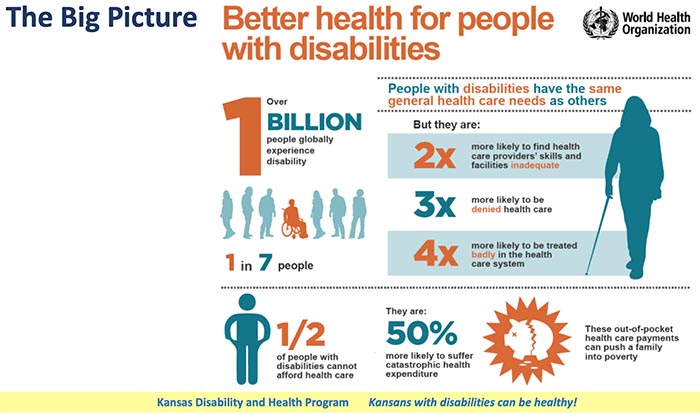Researchers write chapters for book on disability in public health, gaps in coverage

LAWRENCE — Two University of Kansas researchers have contributed chapters for a book on the history of disability as part of public health and how insurance influences health outcomes for individuals with disabilities.
Jean Hall and Dot Nary contributed chapters to “Public Health Perspectives on Disability: Science, Social Justice, Ethics and Beyond” second edition, a book designed to help rethink disability in public health study and practice. The source book, published this year by Springer, collects new research on disability and its intersection with social justice for students, educators, public health officials and policymakers.
Disability and public health history
 Nary, assistant research professor in the Research & Training Center on Independent Living in KU’s Life Span Institute, co-wrote a chapter on the history and evolution of disability as part of public health. In “Disability and Health Programs: Emerging Partners,” Nary and Lindsey Catherine Mullis of the University of Kentucky outline how individuals with disabilities experience significant health disparities and how programs developed in the last 50 years address such issues.
Nary, assistant research professor in the Research & Training Center on Independent Living in KU’s Life Span Institute, co-wrote a chapter on the history and evolution of disability as part of public health. In “Disability and Health Programs: Emerging Partners,” Nary and Lindsey Catherine Mullis of the University of Kentucky outline how individuals with disabilities experience significant health disparities and how programs developed in the last 50 years address such issues.
“There wasn’t an effort to promote health of people with disabilities in the past, because they were viewed as sick. This chapter looks at the growing, changing field,” Nary said. “It really has been a sea change in how disability is viewed.”
The chapter outlines how that sea change happened, from disability rights and independent living movements gaining traction in the 1970s to Centers for Disease Control and Prevention efforts to create programs to support health for people with disabilities in the '80s. The authors also trace the history of major legislation like the Americans with Disabilities Act and illustrate that despite significant progress, challenges such as barriers to health care remain. Social justice issues, notably the intersection of health disparities for individuals with disability and racial and ethnic minorities, are still compounded in society, which will require systemic change beyond health systems, the authors wrote.
Health insurance, employment and disability
 Hall, director of the Research & Training Center on Independent Living and the Institute for Health & Disability Policy Studies, wrote “The Interrelationship of Health Insurance and Employment for People with Disabilities.” The chapter illustrates how America’s health insurance system is different from other industrialized nations. Largely tied to employment, it can be especially problematic for those with disabilities. Often, people cannot work full time, therefore unable to access insurance, yet they have higher health care costs than others. Many people with disabilities are then forced to rely on public assistance programs to access health care, and if they are employed, they can lose it, forcing them to live in poverty with insurance and no employment, or employed and poor without insurance.
Hall, director of the Research & Training Center on Independent Living and the Institute for Health & Disability Policy Studies, wrote “The Interrelationship of Health Insurance and Employment for People with Disabilities.” The chapter illustrates how America’s health insurance system is different from other industrialized nations. Largely tied to employment, it can be especially problematic for those with disabilities. Often, people cannot work full time, therefore unable to access insurance, yet they have higher health care costs than others. Many people with disabilities are then forced to rely on public assistance programs to access health care, and if they are employed, they can lose it, forcing them to live in poverty with insurance and no employment, or employed and poor without insurance.
Hall also includes research showing how programs like Medicare and Medicaid do and don’t meet people’s needs, and how recent changes through the Affordable Care Act and states expanding Medicaid have helped people gain employment and enjoy better health care access and health outcomes. The chapter also examines how the current system can prove ineffective.
“It points out why we need to have a more comprehensive health care system,” Hall said of the chapter. “The pandemic has really illustrated how much of a patchwork system we have and how the problems caused by that are multiplied for people with disabilities.”
The book, edited by Donald Lollar and Willi Horner-Johnson of Oregon Health & Science University and Katherine Froehlich-Grobe of Baylor Scott and White Institute for Rehabilitation, also contains chapters on social determinants of health and disability, environmental contexts shaping disability and health, public health ethics, children with special health care needs, aging with a disability and more.
Nary and Hall said the COVID-19 pandemic has provided highly visible examples of disparities in the health care system for individuals with disabilities. Many vaccination clinics are drive-through only, yet some individuals with disabilities cannot drive. Cases have also been documented of people diagnosed with COVID-19 and placed in hospice care instead of being medically treated because of their disability. Such problems are not only contained on the fringes of society or isolated incidents, and they show why disability needs to be part of public health conversations and policy, the researchers said.
“People with disabilities are the largest minority in our country — and the only minority category that anyone can join at any time — yet it is largely overlooked in public health,” Hall said.
Image credit: World Health Organization